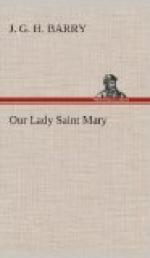It is a striking enough scene, as the artists have felt when they tried to put it before us. But no artist has ever been able to go below the surface and by any hint lead us to an appreciation of the vast implications of the moment. This moment of the Annunciation is in fact the central moment of the world’s history. No moment before or since has equalled it in its unspeakable wonder, in its revelation of the meaning of God. Not the moment of the creation when all the Sons of God sang together at the vision of the unfolding purpose of God; not the morning of the Resurrection when the empty tomb told of the accomplished overthrow of death and hell. This is the moment toward which all preceding time had moved, and to which all succeeding ages will look back—the moment of the Incarnation of God.
It is well to ask ourselves at this point what the Incarnation means, because our estimate of Blessed Mary as the chosen instrument of God’s grace will be influenced by our estimate of that which she was chosen to do. One feels the failure to grasp her position in the work of our redemption often displays a weak hold upon that which is the very heart of God’s work—the fact of God made man. The moment of the Annunciation is the moment of the Incarnation: God in His infinite love for mankind is sending forth His Son to be born of a woman in the likeness of our flesh. God the Son, the second Person of the ever adorable Trinity, is entering the womb of this maiden, there to wrap Himself in her flesh and to pass through the common course of a human child’s development till He shall reach the hour of the Nativity. When we try to grasp the reach of the divine Love, its depth, its self-forgetfulness, we must stand in the cottage in Nazareth and hear the angelic salutation. And then surely our own hearts cannot fail to respond to the revelation of the divine love; and something of our love that goes out to our hidden Lord, goes out too to the maiden-mother who so willingly became God’s instrument in His work for our redemption. In imagination I see S. Gabriel kneeling before her who has become a living Tabernacle of God Most High, and repeating his “Hail, thou that art highly favoured,” with the deepest reverence.
“Hail, thou that art full of grace.” We linger over this Ave of S. Gabriel, and often it rises to our lips. Perhaps it is with S. Luke’s narrative, almost naked in its simplicity, in our hands as we try once more to push our thought deep into the meaning of the scene, that we may understand a little better what has resulted in our experience from the Incarnation of God, and our thought turns to S. Mary whom God chose and brought so near to Himself. Perhaps it is when, with chaplet in hand, we try to imagine S. Mary’s feelings at this first of the Joyful Mysteries when the meaning of her vocation comes clearly before her. Hail! thou that art full of grace, of the Living Grace, the very Presence of the divinity itself. The plummet of our thought




